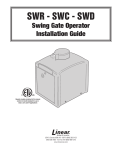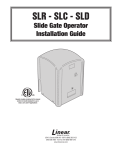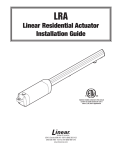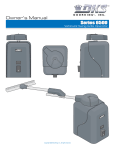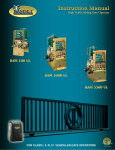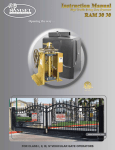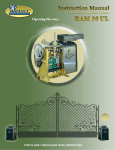Download DKS 1803PC Owner`s manual
Transcript
Owner’s Manual Model 9150 Vehicular Slide Gate Operator DoorKing, Inc. 120 Glasgow Avenue Inglewood, California 90301 U.S.A. Phone: 310-645-0023 Fax: 310-641-1586 www.doorking.com P/N 9150-065 REV B, 7/01 Copyright 2000 DoorKing, Inc. All rights reserved. ii Use this manual with the following models only. Models 9150-080, 9150-081, 9150-082, 9150-083, 9150-084, 9150-085, 9150-086, 9150-087, 9150-088, 9150-089, 9150-090, 9150-091 slide gate operators with circuit board 4602-010. NOTE: Models 9150-082, 9150-083, 9150-085, 9150-086, 9150-087, 9150-091 will have a supplemental manual (P/N 2340-065) that describes the operation and setup of the optional battery backup system available with these units, and provides additional wiring information for these units. DoorKing, Inc. reserves the right to make changes in the products described in this manual without notice and without obligation of DoorKing, Inc. to notify any persons of any such revisions or changes. Additionally, DoorKing, Inc. makes no representations or warranties with respect to this manual. This manual is copyrighted, all rights reserved. No portion of this manual may be copied, reproduced, translated, or reduced to any electronic medium without prior written consent from DoorKing, Inc. iii IMPORTANT NOTICES Vehicular gate systems provide convenience to their users and limit vehicular traffic onto your property. These systems can produce high levels of force; therefore it is important that you are aware of possible hazards associated with your gate operating system. These hazards may include pinch points, entrapment, absence of controlled pedestrian access or traffic backup. Be sure that the installer has instructed you on the proper operation of the gate and gate operator system. Be sure that the installer has trained you about the basic functions of the required reversing systems associated with your gate operating system and how to test them. These include reversing loops, inherent reversing system, electric edges, photoelectric cells, or other external devices. • This Owner's Manual is your property. Keep it in a safe place for future reference. • Loops and loop detectors must be installed with this gate operator to prevent the gate from closing on vehicular traffic. • The speed limit for vehicular traffic through the gate area is 5 MPH. Install speed bumps and signs to keep vehicular traffic from speeding through the gate area. Failure to adhere to posted speed limits can result in damage to the gate, gate operator, and to the vehicle. • Be sure that all residents are familiar with the proper use of the gate and gate operator. Be sure that all residents are familiar with the possible hazards associated with the gate system. • Be sure that all warning signs are permanently installed on both sides of the gate in an area where they are fully visible to traffic. • It is your responsibility to periodically check all reversing devices. If any of these devices are observed to function improperly, remove the operator from service immediately and contact your installing or servicing dealer. • Follow the recommended maintenance schedule. • Do not allow children to play in the area of the operator or to play with any gate-operating device. • Be sure that all activating devices are installed a minimum distance of 10 feet away from the gate and gate operator, or in such a way that a person cannot touch the gate or gate operator while using the activating device. If activating devices are installed in violation of these restrictions, immediately remove the gate operator from service and contact your installing dealer. • To remove the gate operator from service, operate the gate to the full open position and then shut off power to the operator at the service panel. SPEED BUMP HAZARD AREA SPEED BUMP iv PEDESTRAINS VEHICULAR TRAFFIC HAZARD AREA IMPORTANT SAFETY INSTRUCTIONS WARNING - To reduce the risk of injury or death: 1. READ AND FOLLOW ALL INSTRUCTIONS. 2. Never let children operate or play with gate controls. Keep the remote control away from children. 3. Always keep people and objects away from gate. NO ONE SHOULD CROSS THE PATH OF THE MOVING GATE. 4. Test the operator monthly. The gate MUST reverse on contact with a rigid object or stop or reverse when an object activates the non-contact sensors. After adjusting the force or the limit of travel, retest the gate operator. Failure to adjust and retest the gate operator properly can increase the risk of injury or death. 5. KEEP GATES PROPERLY MAINTAINED. Read the owner's manual. Have a qualified service person make repairs to gate hardware. 6. The entrance is for vehicles only. Pedestrians must use separate entrance. 7. SAVE THESE INSTRUCTIONS! v RESTRICTIONS AND WARNINGS Install The Gate Operator Only If: The operator is appropriate for the usage Class of the application and the gate is within the weight and length limitations specified for the operator. • All openings of a horizontal slide gate are guarded or screened from the bottom of the gate to a minimum of 4 feet (1.2 m) above the ground to prevent a 2 ¼ inch (57.15 mm) diameter sphere from passing through the openings anywhere in the gate, and in that portion of the adjacent fence that the gate covers in the open position. • All exposed pinch points are eliminated or guarded. • This operator is intended for installation only on slide gates used to control vehicular traffic. Pedestrians must be provided with a separate access opening. • The gate must be installed in a location so that sufficient clearance is provided between the gate and adjacent structures when opening and closing to reduce the risk of entrapment (see diagram). Sliding gates should not open into public access areas. • The gate must be properly installed and work freely in both directions prior to the installation of the gate operator. Do not over-tighten the operator clutch to compensate for a damaged gate. • Controls must be far enough from the gate so that the user is prevented from coming in contact with the gate while operating the controls. Outdoor or easily accessible controls should have a security feature to prevent unauthorized use. • All warning signs and placards must be installed where visible in the area of the gate. All openings of a horizontal slide gate are guarded or screened from the bottom of the gate to a minimum of four (4) feet (1.2 m) above the ground to prevent a 2 1/4 inch (57.15 mm) diameter sphere from passing through the openings anywhere in the gate and in that portion of the adjacent fence that the gate covers in the open position. ( r e f . U L 3 2 5 51.8.4.a.2) Fence Roadway Gate Operator Vehicular Gate Sidewalk Fence Pedestrian Access • Fence The operator is intended for installation only on gates used for vehicles. Pedestrians must be supplied with a seperate access opening. (ref. UL325 51.8.4.b) Gate 4 ft. min V-Track Spacing must be such that a 2 1/4 inch sphere cannot pass through. vi ENTRAPMENT PROTECTION This vehicular gate operator is equipped with an inherent (Type A) entrapment sensing system. This system will sense an obstruction in both the opening and closing gate cycles, and will cause the gate to reverse direction should an obstruction be encountered. If the system detects a second obstruction before reaching the full open or close limit after the initial reversal, an alarm will activate and the operator will require a reset before resuming normal operation. See Section 4 for more information. EXTERNAL ENTRAPMENT PROTECTION Non-contact and/or contact sensors must be installed individually or in combination with each other to provide external entrapment protection. For gate operators utilizing a non-contact sensor: • See diagram below for placement of non-contact sensors. • Care should be exercised to reduce the risk of nuisance tripping, such as when a vehicle trips the sensor while the gate is still moving, and • One or more non-contact sensors shall be located where the risk of entrapment or obstruction exists, such as the perimeter reachable by a moving gate or barrier. Open beam protects area between the gate and adjacent fence during the open cycle. Fence Gate Entrapment area exist between the gate and the adjacent fence when the gate is in the opening cycle. Close beam prevents gate from hitting obstructions during the close cycle. For gate operators utilizing a contact sensor: • A hardwired contact sensor shall be located and it’s wiring arranged so that the communication between the sensor and the gate operator is not subjected to mechanical damage. • A wireless contact sensor such as one that transmits radio frequency (RF) signals to the gate operator for entrapment protection functions shall be located where the transmission of the signals are not obstructed or impeded by building structures, natural landscaping or similar obstruction. A wireless contact sensor shall function under the intended end-use conditions. Fence Outside Gate Trailing Edge Inside Entrapment area exist between the gate and the adjacent fence when the gate is in the opening cycle. vii Leading Edge GLOSSARY GATE – A moving barrier such as a swinging, sliding, raising, lowering, or the like, barrier, that is a stand-alone passage barrier or is that portion of a wall or fence system that controls entrance and/or egress by persons or vehicles and completes the perimeter of a defined area. RESIDENTIAL VEHICULAR GATE OPERATOR-CLASS I - A vehicular gate operator (or system) intended for use in a home of one-to four single family dwelling, or garage or parking area associated therewith. COMMERCIAL / GENERAL ACCESS VEHICULAR GATE OPERATOR-CLASS II - A vehicular gate operator (or system) intended for use in a commercial location or building such as a multi-family housing unit (five or more single family units), hotels, garages, retail store, or other building servicing the general public. INDUSTRIAL / LIMITED ACCESS VEHICULAR GATE OPERATOR-CLASS III - A vehicular gate operator (or system) intended for use in an industrial location or building such as a factory or loading dock area or other locations not intended to service the general public. RESTRICTED ACCESS VEHICULAR GATE OPERATOR-CLASS IV - A vehicular gate operator (or system) intended for use in a guarded industrial location or building such as an airport security area or other restricted access locations not servicing the general public, in which unauthorized access is prevented via supervision by security personnel. SYSTEM - In the context of these requirements, a system refers to a group of interacting devices intended to perform a common function. WIRED CONTROL - A control implemented in a form of fixed physical interconnections between the control, the associated devices, and an operator to perform predetermined functions in response to input signals. WIRELESS CONTROL - A control implemented in means other than fixed physical interconnections (such as radio waves or infrared beams) between the control, the associated devices, and an operator to perform predetermined functions in response to input signals. INHERENT ENTRAPMENT SENSOR SYSTEM - An automatic sensor system, which senses entrapment of a solid object and is incorporated as a permanent and integral part of the operator. ENTRAPMENT – The condition when an object is caught or held in a position that increases the risk of injury. viii TABLE OF CONTENTS Section 1 – Installation 1.1 Specifications ....................................................................................................................................... 1 1.2 Mounting Positions 1.2.1 1.3 1.4 1.5 Front Position Post Mount .................................................................................................... 2 1.2.3 Rear Position Pad or Post Mount.......................................................................................... 3 1.2.4 Center Position Post Mount .................................................................................................. 3 Mounting Options 1.3.1 Pad Mounted Operators........................................................................................................ 4 1.3.2 Post Mounted Operators....................................................................................................... 5 Operator Installation 1.4.1 Pad Mounted Operators........................................................................................................ 6 1.4.2 Post Mounted Operators....................................................................................................... 6 Chain Installation 1.5.1 1.6 Front Position Pad Mount ..................................................................................................... 2 1.2.2 Front – Pad Mount ................................................................................................................ 7 1.5.2 Front – Post Mount ............................................................................................................... 8 1.5.3 Rear – Pad or Post Mount .................................................................................................... 9 1.5.4 Center – Post Mount............................................................................................................. 10 Warning Sign Installation...................................................................................................................... 11 Section 2 – Wiring Conduits ............................................................................................................................................... 13 2.1 High Voltage Connections .................................................................................................................... 14 2.2 Control Wiring ...................................................................................................................................... 15 2.3 Secondary Entrapment Protection Device Wiring 2.4 2.3.1 Non-Contact Sensors ........................................................................................................... 16 2.3.2 Contact Sensors ................................................................................................................... 17 Loop Detector Wiring............................................................................................................................ 18 2.5 Gate Tracker™ Connections ................................................................................................................ 19 2.6 Auxiliary Devices 2.7 2.8 2.6.1 Alarm Reset Switch .............................................................................................................. 20 2.6.2 Auxiliary Stop Switch ............................................................................................................ 20 Master / Slave Wiring 2.7.1 Operator Interface................................................................................................................. 21 2.7.2 Secondary Entrapment Protection Device Wiring ................................................................. 22 Terminal Identification and Description 2.8.1 Main Terminals ..................................................................................................................... 23 2.8.2 Auxiliary Terminals ............................................................................................................... 24 Section 3 – Adjustments 3.1 3.2 Circuit Board Adjustments .................................................................................................................... 25 Switch Settings..................................................................................................................................... 26 3.2.1 SW 1 (Left Switch) Description and Function........................................................................ 27 3.2.2 SW 2 (Right Switch) Description and Function ..................................................................... 27 3.3 Limit Adjustment................................................................................................................................... 28 3.4 Inherent Reverse Adjustment 3.4.1 Reverse Sensitivity Adjustment ............................................................................................ 29 3.4.2 Clutch Adjustment ................................................................................................................ 30 ix Section 4 – Operating Instructions 4.1 Power and Reset Switches................................................................................................................... 31 4.2 Shutdown Conditions 4.2.1 4.3 Soft Shutdown ...................................................................................................................... 32 4.2.2 Resetting a Soft Shutdown ................................................................................................... 32 4.2.3 Hard Shutdown..................................................................................................................... 33 4.2.4 Resetting a Hard Shutdown .................................................................................................. 33 Manual / Emergency Gate Operation 4.3.1 Emergency Vehicle Access Conditions ................................................................................ 34 4.3.2 Fail-Safe Manual Operation .................................................................................................. 34 4.3.3 Fail-Secure Manual Operation .............................................................................................. 35 Section 5 – Maintenance and Troubleshooting 5.1 Maintenance Schedule ......................................................................................................................... 37 5.2 Trouble Shooting .................................................................................................................................. 38 5.3 Accessories.......................................................................................................................................... 41 Wire Diagram 120 VAC ½ HP .............................................................................................................. 42 Wire Diagram 120 VAC 1 HP ............................................................................................................... 43 Wire Diagram 230 VAC ½ HP .............................................................................................................. 44 Wire Diagram 230 VAC 1 HP ............................................................................................................... 45 Wire Diagram 230 / 460 VAC 3-Pfase ½ HP ........................................................................................ 46 Wire Diagram 230 / 460 VAC 3-Phase 1 HP ........................................................................................ 47 x SECTION 1 - INSTALLATION Prior to beginning the installation of the slide gate operator, we suggest that you become familiar with the instructions, illustrations, and wiring guide-lines in this manual. This will help insure that your installation is performed in an efficient and professional manner. The proper installation of the vehicular slide gate operator is an extremely important and integral part of the overall access control system. Check all local building ordinances and building codes prior to installing this operator. Be sure your installation is in compliance with local codes. 1.1 SPECIFICATIONS Class of Operation: Type of Gate: Horsepower: Voltage / Phase: Current: Max Gate Weight: Max Gate Length: Cycles / Hr: Speed: Entrapment Protection: Note 1: Class I, II, III, IV Vehicular Slide Gates Only 1/2 and 1 H.P. 120 or 230 VAC single-phase; 230 or 460 VAC three phase. Varies with motor, voltage and phase. See page 14. 1 ½ HP – 1000 Lb., 1 HP - 1500 Lbs. 1 ½ HP – 30 Ft., 1 HP - 45 Ft. 60/Hr Approximately 1 Ft./Sec. Primary – Inherent (Type A) Secondary – Provision for connection of a non-contact sensor (Type B1) and/or a contact sensor (Type B2). Secondary entrapment protection devices are not supplied with the operator and must be ordered separately. Assumes gate is in good working condition installed on a level surface. 15 24 18 16.5 Figure 1 1 1.2 MOUNTING POSITIONS The Model 9150 operator is designed so that it can be installed in any of the mounting positions shown below. Once the mounting position has been determined, the chain idlers must be adjusted to accommodate the mounting position chosen before the operator is mounted to the pad or post. The idlers are factory set for the front, pad mount position. (Note: Rear and center position, and postmounted operators require additional hardware not supplied with the operator). FRONT POSITION PAD MOUNT • This is considered the standard method of installing slide gate operators. • Set both chain idlers in the top position (factory setting). • Remove the TOP chain knockouts from each side of the operator. • Chain passes through the operator and is attached to each end of the gate. Figure 2 1.2.2 FRONT POSITION POST MOUNT • Set both chain idlers in the bottom position. • DO NOT remove chain knockouts. Using this mounting method, the chain enters and exits the operator from the bottom. • Chain passes through the operator and is attached to each end of the gate. • This mounting method allows for Figure 3 the use of chain support attached to the gate. This is useful with long gates and helps prevent chain “stretching.” • ADDITIONAL HARDWARE REQUIRED: Post Mount Base Plate P/N 2600-495 and two (2) 6” x 6” steel mounting post at least three feet in length. Mounting post are not available from DoorKing. 2 1.2.3 REAR POSITION PAD OR POST MOUNT • Set one chain idler at the top position and one chain idler at the center position on the same side of the operator. • Remove the top and bottom chain knockouts from the side of the operator. • Chain enters and exits the operator from the same side. Chain is attached to one end of the gate. • This mounting method hides the chain when looking at the gate from the front. • ADDITIONAL HARDWARE REQUIRED: Endless Idler Assembly P/N 2600-818. Additional length of #40 Chain P/N 2600-442 (20 ft.). Note: additional chain may be required depending on the length of the gate. • If operator is post mounted: Post Mount Base Plate P/N 2600-495 and two (2) 6” x 6” steel mounting post at least three feet in length. Mounting post are not available from DoorKing. Figure 4 1.2.4 CENTER POSITION POST MOUNT • Set both chain idlers in the bottom position. • DO NOT remove chain knockouts. Using this mounting method, the chain enters and exits the operator from the bottom. • Chain passes through the operator and is attached to one end of the gate. • This mounting method allows for Figure 5 the use of chain support attached to the gate. This is useful with long gates and helps prevent chain “stretching.” • ADDITIONAL HARDWARE REQUIRED: Two (2) Endless Idler Assemblies P/N 2600-818. Additional length of #40 Chain P/N 2600-442 (20 ft.). Note: additional chain may be required depending on the length of the gate. Post Mount Base Plate P/N 2600-495 and two (2) 6” x 6” steel mounting post at least three feet in length. Mounting post are not available from DoorKing. 3 1.3 MOUNTING OPTIONS Pad mounting can be used when the operator will be installed using either the front or rear mounting position. If the operator is to be center mounted, the post mounting method must be used. 1.3.1 PAD MOUNTED OPERATORS 1. Construct a form for the mounting pad according to the specifications shown in figure 6. Be sure to level the top edge of the form and that the top of the form is a minimum of four (4) inches above ground level. We suggest that you contact the local building department to determine the required depth of the pad since soil conditions and code requirements vary from city to city. 2. Set conduits, reinforcing bars and/or wire mesh if required. The number of conduits is determined by the application requirements. We suggest using a minimum of four (4) conduits. 1-High voltage power lines; 2-Low voltage control lines; 3-Loop lead-in wires (open loop); 4-Loop lead-in wires (reverse loops). See SECTION 2. Set additional conduits as required for your application. NOTE: If conduits are not set in the pad, they can be routed to a J box where connections to the operator can be made after it is installed. There are three (3) ½inch knockouts and one (1) ¾-inch knockout on each side of the operator for this purpose. 3. Mix the concrete according to the manufacturers instructions. Pour the mixture into the form and tamp. Level and finish the surface after pouring is complete. Do not set anchor bolts in the concrete. Sleeve anchors should be used to secure the operator to the pad. This allows greater flexibility in positioning the operator on the pad. 4. Allow the pad to cure for 48 hours before removing the forms or mounting the operator. Gate 5 6.5 Minimum 1" clearance between gate and back of operator. 21.5 4.5 Conduits can be located in shaded areas. 7.5 26 4" minimum above ground level Ground Level Conduits Depth of pad determined by soil conditions and local code Figure 6 4 1.3.2 POST MOUNTED OPERATORS Post mounting can be used when the operator will be installed in any of the three mounting positions, and must be used if the operator is to be center mounted. Gate 1. Post mounting the operator requires the use of an operator base plate (P/N 2600-495) and two (2) 6 X 6 steel post (not supplied) welded to the base plate as shown in figure 7. The length 6 x 6 Steel Post of the steel post and the depth of the (not supplied) pad are determined by soil conditions and local code requirements. We 1.5 suggest that you contact the local building department to determine the required depth of the pad since soil 6.5 conditions and code requirements Base Plate vary from city to city. P/N 2600-495 2. After the posts have been welded to the base plate to form the mounting plate assembly, construct a form for Figure 7 the assembly according to the specifications in figure 8. 3. Position the mounting plate assembly into the form. Be sure that the base plate is a minimum of four (4) inches above ground level. Set conduits, reinforcing bars and/or wire mesh if required. The number of conduits is determined by the application requirements. We suggest using a minimum of four (4) conduits. 1-High voltage power lines; 2-Low voltage control lines; 3-Loop lead-in wires (open loop); 4-Loop lead-in wires (reverse loops). See SECTION 2. Set additional conduits as required for your application. NOTE: If conduits are not set in the pad, they can be routed to a J box where connections to the operator can be made after it is installed. There are three (3) ½-inch knockouts and one (1) ¾-inch knockout on each side of the operator for this purpose. IMPORTANT!! Be sure that the mounting plate is level and parallel with the gate. 4. Secure the mounting plate assembly in the form. Mix the concrete according to the manufacturers instructions. Pour the mixture into the form and tamp. Level and finish the surface after pouring is complete. 5. Allow the pad to cure for 48 hours before removing the forms or mounting the operator. 4 inch minimum Conduits Depth of pad determined by soil conditions and local code. 24 14 Figure 8 5 1.4 OPERATOR INSTALLATION Prior to mounting the gate operator, be sure that the chain knockouts and chain idlers are set for the mounting position (front, center or rear) and the mounting option chosen (pad or post). Refer back to SECTION 1.2. 1.4.1 PAD MOUNTED OPERATORS • Position the operator on the pad so that there is a minimum clearance of one (1) inch between the back of the operator housing and the gate. • IMPORTANT!! Be sure that the operator is parallel to the gate! Installing the operator in any other manner will cause excessive chain noise, chain wear and stretching, and premature idler failure. • Mark the mounting holes on the mounting pad. Use a concrete drill bit to drill the mounting holes to the size and depth required for the anchors being used. We recommend minimum 3/8 x 2 sleeve anchors (not supplied). • After drilling the mounting holes, clean them out and install the sleeve anchors. Position the operator over the anchors and tighten. 90° Figure 9 1.4.2 POST MOUNTED OPERATORS • Position the operator on the mounting plate so that the mounting holes are in alignment. If the mounting plate/post assembly has been installed correctly, there should be a minimum of one (1) inch clearance between the back of the operator housing and the gate, and the operator should be parallel to the gate. If these conditions do not exist, make corrections now! • IMPORTANT!! Be sure that the operator is parallel to the gate! Installing the operator in any other manner will cause excessive chain noise, chain wear and stretching, and premature idler failure. • Secure the operator to the mounting plate/post assembly using six (6) ½-13 x 1 ½ bolts, lock washers and nuts (or equivalent hardware). NOTE: Hardware is not supplied with the operator or mounting plate. 6 1.5 CHAIN INSTALLATION 1.5.1 FRONT – PAD MOUNT 1. Secure the chain brackets to each end of the gate so that the brackets are level with the top chain knockouts in the operator housing. Brackets should be attached to the inside of the frame so that the chain bolts, when attached, do not protrude beyond the frame of the gate (figure 10). 2. Route the chain through the gate operator: over the chain guide idlers and under the drive sprocket (figure 12). 3. Slide each end of the chain through a chain stop (optional). Chain stops are not required if the gate has physical stops. 4. Attach the chain to the chain bolts using the master links supplied, and then attach the chain bolts to the chain brackets using the hardware supplied (figure 10). Make any adjustments to the chain length at this time. 5. Adjust the chain bolts to tighten the chain. The chain should sag no more than one (1) inch per 10 feet of travel. Do not over tighten the chain. IMPORTANT!! Be sure that the chain is parallel to the gate (figure 11). Installing the chain in any other manner will cause excessive noise, chain idler wear and chain stretching. 6. Manually open the gate to the full open position and secure the chain stop (if installed) to the chain so that it is in contact with the operator housing. 7. Manually close the gate to the full closed position and secure the chain stop (if installed) to the chain so that it is in contact with the operator housing. Figure 12 7 Figure 10 Figure 11 1.5.2 FRONT – POST MOUNT 1. Secure the chain brackets to each end of the gate so that the brackets are level with the bottom chain idlers in the operator housing. Brackets should be attached to the inside of the frame so that the chain bolts, when attached, do not protrude beyond the frame of the gate. 2. Route the chain through the gate operator: under the chain guide idlers and over the drive sprocket (Figure 15). 3. Slide each end of the chain through a chain stop (optional). Chain stops are not required if the gate has physical stops. 4. Attach the chain to the chain bolts using the master links supplied, and then attach the chain bolts to the chain brackets using the hardware supplied (figure 13). Make any adjustments to the chain length at this time. 5. Adjust the chain bolts to tighten the chain. The chain should sag no more than one (1) inch per 10 feet of travel. Do not over tighten the chain. IMPORTANT!! Be sure that the chain is parallel to the gate (figure 14). Installing the chain in any other manner will cause excessive noise, chain idler wear and chain stretching. 6. Manually open the gate to the full open position and secure the chain stop (if installed) to the chain so that it is in contact with the operator housing. 7. Manually close the gate to the full closed position and secure the chain stop (if installed) to the chain so that it is in contact with the operator housing. Figure 13 Figure 14 Figure 15 8 1.5.3 REAR – PAD OR POST MOUNT 1. Install an endless idler assembly (p/n 2600-818) at the gate opening between the gate and fence (figure 16, 18). Note that the chain is routed between the fence and the gate in this type of installation. IMPORTANT!! Be sure that the idler assembly is securely attached to the gatepost, pilaster, etc. 2. Secure the chain brackets to the gate as shown in figure 16. The chain brackets should be attached to the gate frame so that they are approximately one (1) inch apart. 3. Route the chain through the gate operator: over the chain guide idlers and around the drive sprocket (Figure 18), and around the idler assembly. 4. Attach the chain to the chain bolts using the master links supplied, and then attach the chain bolts to the chain brackets using the hardware supplied (figure 16). Make any adjustments to the chain length at this time. 5. Adjust the chain bolts to tighten the chain. The chain should sag no more than one (1) inch per 10 feet of travel. Do not over tighten the chain. IMPORTANT!! Be sure that the chain is parallel to the gate (figure 17). Figure 16 Installing the chain in any other manner will cause excessive noise, chain idler wear and chain stretching. 6. Manually operate the gate to be sure that the chain is not binding and that the gate operates easily. Figure 17 Figure 18 9 1.5.4 CENTER – POST MOUNT 1. Install an endless idler assembly (p/n 2600-818) at each end of the gate opening (figure 21). Note that the gate travels between the fence and the chain in this type of installation. IMPORTANT!! Be sure that the idler post/mount assembly is secure. 2. Secure the chain brackets to the gate as shown in figure 19. The chain brackets should be attached to the gate frame so that they are approximately one (1) inch apart. 3. Route the chain through the gate operator: under the chain guide idlers and over the drive sprocket (Figure 21), and then around the two idler assemblies. 4. Attach the chain to the chain bolts using the master links supplied, and then attach the chain bolts to the chain brackets using the hardware supplied (figure 19). Make any adjustments to the chain length at this time. 5. Adjust the chain bolts to tighten the chain. The chain should sag no more than one (1) inch per 10 feet of travel. Do not over tighten the chain. IMPORTANT!! Be sure that the chain is parallel to the gate (figure 20). Installing the chain in any other manner will cause excessive noise, chain idler wear and chain stretching. 6. Manually operate the gate to be sure that the chain is not binding and that the gate operates easily. Figure 19 Figure 20 END VIEW Figure 21 10 1.6 WARNING SIGN INSTALLATION This DoorKing slide gate operator is shipped with two warning signs. The purpose of the warning signs is to alert uniformed persons, and to remind persons familiar with the system, that a potential hazard may exist so that appropriate action can be taken to avoid the hazard or to reduce exposure to the hazard. 1. Permanently install the supplied warning signs in locations so that the signs are visible by persons on both sides of the gate. 2. Use appropriate hardware such as wood or metal screws (not supplied) to install the warnings. WARNING Moving Gate Can Cause Serious Injury or Death KEEP CLEAR! Gate may move at any time without prior warning. Do not let children operate the gate or play in the gate area. This entrance is for vehicles only. Pedestrians must use separate entrance. Figure 22 11 12 SECTION 2 – WIRING Before attempting to connect any wiring to the operator, be sure that the circuit breaker in the electrical panel is in the OFF position. Permanent wiring must be installed to the operator as required by local electrical codes. It is recommended that such work be performed by a licensed electrical contractor. Since building codes vary from city to city, we highly recommend that you check with your local building department prior to installing any permanent wiring to be sure that all wiring to the operator (both high and low voltage) complies with local code requirements. THIS GATE OPERATOR MUST BE PROPERLY GROUNDED!! MASTER OPERATOR MASTER OPERATOR SLIDE GATE CONDUIT REQUIREMENTS (Typical) Low Voltage Control Devices Loop Lead-In Wires High Voltage Power Figure 23 • The conduit requirements shown in figure 23 are for a typical slide gate operator installation (the slave operator is shown for those applications where a slave operator may be used). The conduit requirements for your application may vary from this depending on your specific needs. • Use only sweeps for conduit bends. Do not use 90° connectors as this will make wire pulls very difficult and can cause damage to wire insulation. • We suggest that minimum ¾-inch conduit be used. • Be sure that all conduits are installed in accordance with local codes. 13 2.1 HIGH VOLTAGE CONNECTIONS Use Table 1 to determine high voltage wire size requirements. The distance shown in the chart is measured in feet from the operator to the power source. If power wiring is greater than the maximum distance shown, it is recommended that a service feeder be installed. When large gauge wire is used, a separate junction box must be installed for the operator connection. The wire table is based on stranded copper wire. Wire run calculations are based on a 3% voltage drop on the power line, plus an additional 10% reduction in distance to allow for other losses in the system. MODEL VOLTS AMPS WIRE SIZE / DISTANCE IN FEET / SINGLE OPERATOR 12 AWG 10 AWG 8 AWG 6 AWG 9150 ½ HP 120 5.4 170 275 460 685 9150 ½ HP 230 2.7 685 1100 1830 2750 9150 ½ HP 460 1.35 2875 4600 7665 11500 9150 1 HP 120 14.0 130 210 350 530 9150 1 HP 230 7.0 530 845 1415 2120 9150 1 HP 460 3.5 1110 1775 2955 4435 Table 1 Route incoming high voltage power through conduit and into the operator as shown in figure 24. • Be sure wiring is installed in accordance with local codes. Be sure to color code all wiring. • Connect the power wires as shown. • It is recommended that a surge suppresser be installed on the high voltage power lines to help protect the operator and circuit board from surges and power fluctuations. • Note: For 230 and 460 Volt 3-phase input power, use only two legs of the incoming 3phase power. High Voltage Terminal Strip ON-OFF Switch • Conduits 14 GROUND 120 VAC HOT 120 VAC NEUT 120 VAC NEUT 230 / 460 V 230 / 460 V GROUND 120 VAC SWITCHED 120 VAC SWITCHED 120 VAC NEUT 120 VAC NEUT 120 VAC HOT Figure 24 2.2 CONTROL WIRING Controls must be far enough from the gate so that the user is prevented from coming in contact with the gate while operating the controls. Outdoor or easily accessible controls should have a security feature to prevent unauthorized use. • Connect optional control devices to the operator terminal strip as shown in figure 25. Be sure that all electrical connections are made in accordance with local electrical codes. Use 18 AWG wire for all low voltage wiring, maximum distance 3000 feet. Use a low voltage surge suppresser, DoorKing P/N 1878-010 if low voltage wire runs exceed 1000 feet. All inputs to the terminal strip must be NORMALLY OPEN. • Standard reversing input (term 6) only functions while the gate is in the closing cycle and should not be used as an input for a secondary entrapment protection device. See Section 2.3 for secondary entrapment protection device wiring. • Do not power any devices from the circuit board other than a low voltage radio receiver as shown. Power available at terminal 3 is limited to 250 ma at 24 VAC. Three-button control station must be DoorKing P/N 1200-006 only. Others will not work. • If the 14-foot partial open feature is used, connect those devices that are to open the gate 14 feet to terminal 5 as indicated by the dotted lines. The Fire Department access switch should always be connected to the full open input. 1 Radio Receiver Common 2 Radio Receiver Full Open Input 3 Radio Receiver 24 VAC Pwr 4 Full Open Keyswitch 5 14 Ft Open Push Button 6 Standard Reverse 7 Not Used 8 Open Only 9 Close Only Common Relay Power MicroPLUS RF Receiver Lock Boxes Fire Dept Photocell Telephone Entry Systems OPEN CLOSE STOP Digital Keypad 3 Button Control Card Readers 18 Figure 25 15 Common 2.3 SECONDARY ENTRAPMENT PROTECTION DEVICE WIRING Secondary entrapment protection devices must be installed to insure a safe operating environment and to reduce the risk of entrapment. This operator has inputs for non-contact sensors and contact sensors for both opening and closing gate cycles. Secondary entrapment protection may be provided by a combination of both type sensors. See Section 5.3 for a list of acceptable secondary entrapment protection devices. 2.3.1 NON-CONTACT SENSORS • Disconnect power to the gate operator before installing the non-contact sensors. • See figure 26 for suggested placement of sensors. (Diagram is for illustration purposes only. Actual placement of the sensors is dependent on the installation requirements). One or more non-contact sensors shall be located where the risk of entrapment or obstruction exists, such as the perimeter reachable by a moving gate or barrier. • Use only UL listed (or equivalent) non-contact sensors. • Connect the non-contact sensors as shown below to the auxiliary terminal strip located on the 4602 control board. Inputs from photo-beam to circuit board are NORMALLY OPEN. • Diagram does not show power wiring to photo-beams. • Open photo-beam must be placed so that it covers that portion of the fence that the gate covers when it is fully open. Roadway Fence Gate Open direction non-contact sensor Close direction non-contact sensor Close Direction Protection Open Direction Protection Open Photo-Beam Close Photo- Beam Open Edge Close Edge Common Figure 26 16 2.3.2 CONTACT SENSORS • Disconnect power to the gate operator before installing the contact sensors. • Connect the contact sensors as shown below to the auxiliary terminal strip located on the 4602 control board. • Contact sensors must be located at the leading edge, trailing edge, and post mounted both inside and outside of the vehicular sliding gate. Additional contact sensors may be added for additional protection where an entrapment zone may exist. • Hardwired contact sensors must be located and wiring arranged so that the communication between the sensor and the gate operator is not subjected to mechanical damage. • Inputs from sensing edges/receiver to circuit board are NORMALLY OPEN. • Diagram does not show power wiring to RF receiver. Outside Post Mount Fence Gate Trailing Edge Inside Post Mount Leading Edge Trail Edge TX Trailing edge relay Open Photo-Beam Close Photo- Beam Lead Edge TX Lead Edge Trail Edge Outside Post Inside Post Roadway 2 CH Rec'vr Leading edge relay Open Edge Close Edge Common Figure 27 17 2.4 LOOP DETECTOR WIRING Loops and loop detectors must be installed with this gate operator to prevent the gate from accidentally closing on vehicles that may be in the path of the gate. • Loop detector wiring is shown for DoorKing model 9406 Plug-In loop detector only. If other loop detectors are used, refer to the installation instructions supplied with those detectors for wiring requirements. • If other loop detectors are used, all inputs to the terminal strip are NORMALLY OPEN. Use a separate power supply to power external detectors. Be sure that power is turned off prior to making any connections to the terminal strip. • Loop layout shown is for a typical slide gate application with two-way traffic or one-way exit only traffic. For one-way entry only traffic, the open loop and loop detector are not needed. • Refer to the separate Loop Information Manual (available from DoorKing) for instructions on installing loops or preformed loops. • Reverse loops are wired in series (detail A)! TB 1 TB 1 Open Detail A Reverse Loop Detector P/N 9406-010 Loop Detector P/N 9406-010 Plug into OPEN Port Plug into REVERSE Port Reverse From outside Reverse loop From inside Reverse loop TB 1 Detail A Figure 28 18 2.5 GATE TRACKER™ CONNECTIONS This gate operator is equipped with outputs from the circuit board that will report operator status to a companion DoorKing Access Control System (Model 1803PC, 1815, 1817 or 1818) when equipped with an optional Tracker expansion board. This report includes items such as gate operator cycle count, any shorted inputs, loop detector problems, any attempts to force the gate open, if the gate has struck anything during the open or close cycle, power interruptions, etc. Gate Tracker™ connections are made at terminals 3, 4, 13, 14 and 18 on the main terminal strip. For more detailed information on Gate Tracker™ and wiring to the Tracker expansion boards, refer to the Tracker Installation and Wiring Manual, DoorKing P/N 2351-010. Maximum wire run for gate operator data to the tracker board is 500 feet using Belden #9931 shielded cable or Consolidated #5324-CL shielded cable. Float the shield at the tracker board. Do not connect the shield to the tracker board common. Wire connection from the tracker board terminal P1-5 to the 4602 main terminal 4 is optional if the gate operator is not to be activated by the tracker output relay. 4 13 14 Belden #9931 or Consolidated #5324-CL shielded cable or equivalent. 4602 Board Terminals 3 18 Tracker Board P1-6, P2-5 and 11 P2-1 P2-2 P1-5 P2-12 Figure 29 19 2.6.1 ALARM RESET SWITCH The gate operator is equipped with a reset switch that will silence the entrapment alarm and return the operator to normal operation after a hard shutdown occurs. An auxiliary reset button may be added provided that the following condition is met. • The alarm-reset button must be located in the line of sight of the gate. • Connect the normally open alarm-reset switch to auxiliary terminals 11 and 18. AUXILIARY ALARM RESET PUSH BUTTON OPERATOR RESET NORMAL OPERATION 10 11 18 Figure 30 2.6.2 AUXILIARY STOP SWITCH This circuit creates an auxiliary stop input that will stop a moving gate when activated, or will prevent the gate operator from starting if the switch is activated. Note that this stop input is normally open and that a switch closure will activate the stop function. Because this is a normally open circuit, the stop switch is not intended and should not be used as a safety interlock device. • This circuit cannot be used if a DoorKing 3 button control station is connected to the operator. • Place a jumper wire from terminal 8 to terminal 9. • Connect the stop switch to terminals 9 and 18. AUXILIARY STOP USING MAGNETIC SWITCH N.C. N.O. N.O. N.C. 8 9 COM COM 18 OPERATOR STOPPED NORMAL OPERATION AUXILIARY ALARM RESET PUSH BUTTON Figure 31 20 2.7 MASTER / SLAVE WIRING 2.7.1 OPERATOR INTERFACE The interface wiring between the two operators requires four (4) 18 AWG wires for control plus two (2) additional 18 AWG wires for secondary entrapment protection device connection. Each operator must be connected to it's own power source as described in section 2.2. The loop functions are controlled by a two-channel loop detector (P/N 9404-010) plugged into the OPEN port on the operator that is designated as the master unit. 1. Connect the master / slave wiring (terminals 4, 5, 6, 18) as shown in figure 32. Be sure that power to both operators is OFF. 2. Place a jumper wire from terminal 10 to terminal 4 in the MASTER operator. Set SW 2, switch 1 to the OFF position in this operator. 3. Plug the 9405 loop detector into the OPEN loop port. Connect the leads from the OPEN loop to TB 1. Connect the leads from the REVERSE loop(s) to TB 2. Connect TB 3 Normally Open (N.O.) to terminal 6. Connect TB 3 Common (C) to terminal 18. 4. Connect the radio receiver as shown. Note that the relay contact from the radio receiver connects to terminal 4. 5. Connect any other OPEN devices to terminals 4 and 18. Connect standard external REVERSING devices to terminals 6 and 18. See section 2.7.2 for secondary entrapment protection device wiring for master / slave operators. 1 Common Relay 2 Power 3 4 Violet 5 Brown 6 TB 1 TB 2 Slave Operator Open Loop Yellow Master Operator Reverse Loop(s) Yellow 4 Violet 5 Brown 6 Orange 18 9505 Detector 10 TB 3 Orange NOTE : Auxiliary terminals used is dependent on the type of secondary protection used. 18 Aux Terminal Strip Master / Slave Conduit Connect Chassis Ground To Chassis Ground (Green Wire) Figure 32 21 2.7.2 SECONDARY ENTRAPMENT PROTECTION DEVICE WIRING Secondary entrapment protection for slide gate operators connected in a master / slave configuration will require three sets of photo-beams to insure protection. • One photo-beam is directed across the roadway and connected to the CLOSE photo-beam input on the auxiliary terminal strip of both the master and slave operator. This photo-beam is active in the close direction only and will not affect the movement of the gates while the gates are opening. • Two photo-beams are required to protect the open direction of the gates - one for the master operator and one for the slave operator. These photo-beams are connected to the OPEN photo-beam input on the auxiliary terminal strip in their respective operator. These photobeams are active in the open direction only. If a beam is interrupted while the gate(s) are in the open cycle, only the gate that is controlled by the interrupted beam will stop, the other gate will continue in the open direction. Master operator open direction sensor Close direction sensor Open Photo-Beam Close Photo-Beam Slave operator open direction sensor Open Photo-Beam Close Photo-Beam Common Common Master / Slave Conduit Figure 33 22 2.8 TERMINAL IDENTIFICATION AND DESCRIPTION 2.8.1 MAIN TERMINAL 1. 2. 3. 4. 5. 6. 7. 8. 9. 10. 11. 12. 13. 14. 15. 16. 17. 18. RADIO RECEIVER LOW VOLTAGE COMMON RADIO RECEIVER FULL OPEN INPUT RADIO RECEIVER 24 VAC POWER – 250-ma MAX FULL OPEN / CLOSE INPUT When gate is closed, input will open gate to full position. When gate is open and auto close timer is turned on, input will re-set and hold timer. When gate is open and auto close timer is turned off, input will close gate. When gate is closing, input will reverse gate. 14-FOOT OPEN / CLOSE INPUT When gate is closed, input will open gate to 14-foot position. When gate is open and auto close timer is turned on, input will re-set and hold timer. When gate is open and auto close timer is turned off, input will close gate. When gate is closing, input will reverse gate to 14-foot position. STANDARD REVERSE INPUT When gate is fully closed or in the opening cycle, this input has no affect on the gate operator. When gate is open and auto close timer is turned ON, input will re-set and hold timer. When gate is open and auto close timer is turned OFF, input will prevent gate from closing. When gate is closing, input will reverse gate if SW 2, switch 2 is OFF. When gate is closing, input will stop gate if SW 2, switch 2 is ON. NOT USED OPEN INPUT - Use with DoorKing 3 button control station only (P/N 1200-006). CLOSE INPUT - Use with DoorKing 3 button control station only (P/N 1200-006). OPEN LOOP LOGIC OUTPUT If SW 1, switch 1 is OFF, this terminal becomes the logic output of the loop detector plugged into the OPEN loop port (DoorKing loop detectors only). ALARM RESET INPUT ALARM OUTPUT GATE TRACKER - BUSY GATE TRACKER - DATA DRY RELAY CONTACT Operation of relay is dependent on setting of SW 1, switches 4 and 5. Relay contacts can be set for Normally Open (NO) or Normally Closed (NC) operation. Contact rating is 1 amp maximum at 24 Volts. DRY RELAY CONTACT LED INDICATOR OUTPUT - Provides 24 VDC, 250-ma maximum to power LED. Operation of LED is dependent on setting of SW 1, switches 4 and 5. LOW VOLTAGE COMMON 23 2.8.2 AUXILIARY TERMINAL The auxiliary terminal is located on the 4602 circuit board just to the right of main terminals 8 and 9. Auxiliary terminals are numbered 1 through 5 with the first terminal at the top. 1. OPEN PHOTO-BEAM This input is only active when the gate is in the opening cycle. An open photo-beam input during the opening cycle will cause the gate to stop. The gate will remain stopped until the photo-beam input is cleared, at which time the gate will resume the open cycle. 2. CLOSE PHOTO-BEAM This input is only active when the gate is in the closing cycle. A close photo-beam input during the closing cycle will cause the gate to stop. The gate will remain stopped until the photo-beam input is cleared, at which time the gate will resume the close cycle. 3. OPEN EDGE This input is only active when the gate is in the opening cycle. An open edge input during the opening cycle will cause the gate to stop and then reverse. If the gate reaches the full closed position, the gate will remain closed, ignore any maintained inputs and enter a soft shutdown condition. NOTE: If the gate was initially activated by a time clock with a contact closure across the gate operator open input, this input will be ignored until another input (open loop, reverse loop. etc.) is received by the gate operator. If a close edge sensor is activated prior to the gate reaching the full closed position, the gate will stop and enter a soft shutdown condition. 4. CLOSE EDGE This input is only active when the gate is in the closing cycle. A close edge input during the closing cycle will cause the gate to stop and then reverse. If the gate reaches the full open position, the timer will automatically close the gate (if it is turned on). Once the gate starts to close again, if the close edge input is activated a second time prior to the gate reaching the full closed position, the operator will stop and reverse and will enter a soft shutdown condition. If an open edge sensor is activated prior to the gate reaching the full open position, the gate will stop and enter a soft shutdown condition. 5. COMMON Common terminal for the secondary entrapment protection device inputs. 24 SECTION 3 - ADJUSTMENTS The switch settings and adjustments in this chapter should be made after your installation and wiring to the operator(s) is complete. Whenever any of the programming switches on the circuit board are changed, power must be shut-off, and then turned back on for the new setting to take effect. 3.1 CIRCUIT BOARD ADJUSTMENTS • Set the DIP-switches on the circuit board to the desired setting. See switch-setting charts in section 3.2. • Auto close timer (when turned on) can be set from 1 second (full counter clockwise) to approximately 23 seconds (full clockwise). • Dry contact relay (terminals 15-16) can be set for Normally Open (NO) or Normally Closed (NC) operation by placing the relay shorting bar on the NO or NC pins respectively. • Power LED indicates that low voltage power is applied to the circuit board. Input LEDs should be OFF and will only illuminate when the input is activated. The pulse LEDs will blink as the operator is running. They can be either ON or OFF when the operator is stopped. REVERSE Loop Port TIMER ADJUST AUXILIARY TERMINALS POWER LED COUNTER LED's PROGRAMMING SWITCHES RELAY CONTACT Figure 34 25 REVERSE SENSITIVITY INPUT LED's OPEN Loop Port 3.2 SWITCH SETTINGS The two DIP-switches located on the circuit board are used to program the operator to operate in various modes and to turn on or off various operating features. Whenever a switch setting is changed, power to the operator must be turned OFF and then turned back on for the new setting to take affect. Check and review ALL switch settings prior to applying power to the operator. SW 1 (LEFT SWITCH) SWITCH FUNCTION SETTING 1 Direction OFF ON Changes open / close direction of operator. 2 Auto Close Timer OFF ON Auto-close timer is OFF. Manual input required to close gate. Auto-close timer is ON. Adjustable from 1-23 seconds. 3 Motor Hold OFF ON Normal setting. DC braking voltage applied to motor windings. 4&5 Relay & LED 4-OFF 5-OFF 4-OFF 5-ON 4-ON 5-OFF 4-ON 5-ON Relay activated and LED on when gate is FULL OPEN. Relay activated and LED on when gate is NOT CLOSED. Relay activated and LED on when gate is OPENING and OPEN. Relay activated and LED on when gate is OPENING or CLOSING. 6 Self Test OFF ON Normal setting. Runs self test – bench test only. 7&8 Open Back-Off 7-OFF 7-OFF 7-ON 7-ON 8-OFF 8-ON 8-OFF 8-ON DESCRIPTION Normal setting. Back-off 0 inches from full open position. Back-off 1 inch from full open position. Back-off 2 inches from full open position. Back-off 3 inches from full open position. SW 2 (RIGHT SWITCH) SWITCH FUNCTION SETTING 1 Open Loop Output OFF ON Switches logic level output of OPEN loop port to terminal 10. Normal setting. Control board responds internally to loop detector plugged into open loop port. 2 Reverse OFF Stop ON Normal setting. Input to terminal 6 will reverse gate during close cycle. Input to terminal 6 will stop gate during close cycle – gate will continue to close after input is cleared. 3 Partial Open OFF ON Normal setting. Input to terminal 5 opens gate 14 feet. Used for model 9200 operator only. 4 Solenoid Lock OFF Normal Setting. Fail-safe logic. Lock engages only if attempt is made to force gate open. Fail-secure logic. Lock engages after each gate cycle. ON 5 Model Select Normal setting. Switch must be OFF for models 9100 and 9150 operators. Switch is in the ON position for model 9200 operator only. OFF ON 6 Timer Override OFF ON 7&8 Close Back-Off 7-OFF 7-OFF 7-ON 7-ON DESCRIPTION Normal gate operation. Timer defaults to 1 second regardless of timer setting. Gate begins to close after reverse inputs (loops) are cleared regardless of the distance the gate has opened. 8-OFF 8-ON 8-OFF 8-ON Normal setting. Back-off 0 inches from full close position. Back-off 1 inch from full close position. Back-off 2 inches from full close position. Back-off 3 inches from full close position. 26 3.2.1 SW 1 (LEFT SWITCH) DESCRIPTION AND FUNCTION Switch 1: Set so that the operator cycles open upon initial power up and open command. If the operator cycles close, turn power off and change the setting on this switch. Switch 2: Turns the auto close timer on or off. Set from 1 to 23 seconds. Switch 3: This switch should be left in the OFF position when the slide gate is running on a level track and the gate does not coast. If the gate is on an incline, turning this switch on will apply a DC voltage to the motor windings when the gate is stopped. This applies braking power to the motor to prevent the gate from coasting. Switches 4-5: These work in conjunction with each other and determine when the relay on the board will be activated. This relay can be used as a switch for various functions such as illuminating a warning light when the gate is moving, or turning on a green light when the gate is full open. If a magnetic lock is used with the gate operator, these switches must be set for magnetic lock operation which limits the relay to activate only when the gate is opening and full open. Switch 6: This switch must be in the OFF position for normal operation. The self-test feature checks various functions of the operator. CAUTION - Do not run self-test with the operator connected to the gate. The drive chain must be disconnected from the operator to run the self-test. Switches 7-8: These work in conjunction with each other and determine if the operator will stop the gate at the full open position, or if the gate should stop 1, 2 or 3 inches short of the full open position. 3.2.2 SW 2 (RIGHT SWITCH) DESCRIPTION AND FUNCTION Switch 1: Determines if the output of the loop detector (DoorKing loop detectors only) plugged into the OPEN port will be sent directly to the microprocessor to open the gate, or if the output is directed to terminal 10 where it can then be connected to other input terminals. Switch 2: Determines if an input to terminal 6 will reverse or stop a closing gate. If this switch is set to stop the gate (ON), once the input to terminal 6 is cleared, the gate will continue to close. This is typically used to help prevent tailgating. Switch 3: Switch must be in the OFF position for models 9100 and 9150. Switch 4: This switch determines the operation of the solenoid lock and is factory set. CAUTION: Do not change the setting of this switch unless the solenoid / lock assembly has been repositioned for the operation desired. Changing the setting of this switch without physically changing the lock assembly will damage the operator. Switch 5: Switch must be in the OFF position for models 9100 and 9150. Switch 6: Turning the timer override feature on will cause the auto close timer to close the gate after 1 second, regardless of the setting of the auto close timer potentiometer. This will also cause an opening gate to stop and reverse when the reverse (loop) inputs are cleared. This feature, along with switch 2 above, is useful to prevent tailgating. Switches 7-8: These work in conjunction with each other and determine if the operator will stop the gate at the full closed position, or if the gate should stop 1, 2 or 3 inches short of the full closed position. 27 3.3 AUTOMATIC LIMIT ADJUSTMENT This gate operator does not use any mechanical limit switches or run timers to adjust the open and close positions of the gate. The gate open and close positions are determined by the physical stops (or chain stops) of the gate. The gate operator will automatically measure the gate and will set its "limits" from this measurement during this automatic sequence. !! IMPORTANT !! This automatic limit adjustment sequence must be run prior to testing the operator for normal operation, and prior to testing any of the safety features that are incorporated into this operator. This includes the primary and secondary entrapment protection features, and the entrapment alarm and reset features. 1. The limit adjustment is automatic and relies on the physical stop of the gate or on the chain stops installed on the chain. Be sure that the gate has a physical travel limitation in both directions prior to starting this sequence. DoorKing "Gate Stops" can be used if physical stops are not present on the gate. 2. If either the open and/or close back-off feature is going to be used, set SW1 and SW2 switches 7 and 8 to the desired settings (see Section 3.2). 3. Turn power to the operator ON. Activate an open device (or momentarily jumper between terminals 4 and 18). The gate operator should begin to cycle the gate to the OPEN position. 4. If the gate operator begins to cycle the gate to the CLOSED position, turn power to the operator OFF. Change the setting of the direction switch, SW 1 (left switch), switch 1, then repeat step 2. 5. After the gate reaches the full open position, the gate operator will shut off. Activate a keying device to close the gate (or allow the timer to close the gate if it is turned on). When the gate reaches the full closed position, the gate operator will shut off. NOTE: During this initial setup, be sure that the operator clutch does not slip while the gate is cycling from the full open to the full closed position. If the clutch slips during this period, the limits will be misadjusted. 6. After closing, the gate will open automatically and stop approximately one foot from the full open position, and then will continue to the full open position. Activate a keying device to close the gate (or allow the timer to close it if it is turned on). The gate will close and stop approximately one foot from the full closed position, and then will continue to the full close position. 7. The operator limits and coast settings are now set. Cycle the gate again. The operator should reach the full open and full close positions and then shut off automatically. 28 3.4 INHERENT REVERSE ADJUSTMENT This vehicular gate operator is equipped with an inherent (Type A) entrapment sensing system. This system will sense an obstruction in either the opening or closing gate cycles and will cause the gate to reverse direction should an obstruction be encountered. For this system to function correctly, the gate must be properly installed and work freely in both directions. A good set of ball bearing wheels (or rollers) is essential for proper slide gate operation. 3.4.1 REVERSE SENSITIVITY ADJUSTMENT 1. Activate the gate operator my momentarily shorting terminal 4 and 18 with a 1-foot piece of 18 AWG wire. Be sure that the automatic limit adjustment has been completed as described in section 3.3. 2. While the gate is running, slowly rotate the reverse sensitivity potentiometer clockwise until the gate reverses travel, then rotate the potentiometer 1/8 turn counter clockwise. Note: Rotating the sensitivity adjustment clockwise INCREASES the reverse sensitivity. Rotating this adjustment counter-clockwise DECREASES the reverse sensitivity. NOTE: After the gate has reversed, the operator will assume a "soft shutdown" making it necessary to initiate the cycle again by momentarily shorting across terminals 4 and 18 as in step 1. 3. Operate the gate a few times to be sure that it cycles completely. 4. Place an immobile object along the path of the gate so that the gate will strike it while in the open cycle. The gate must reverse direction after striking the object. If it does not, increase the reverse sensitivity by turning the potentiometer 1/8 turn clockwise, then repeat this test. NOTE: After the gate has reversed, the operator will assume a "soft shutdown" making it necessary to initiate the cycle again by momentarily shorting across terminals 4 and 18 as in step 1. 5. Place an immobile object along the path of the gate so that the gate will strike it while in the close cycle. The gate must reverse direction after striking the object. If it does not, increase the reverse sensitivity by turning the potentiometer 1/8 turn clockwise, then repeat this test. NOTE: After the gate has reversed, the operator will assume a "soft shutdown" making it necessary to initiate the cycle again by momentarily shorting across terminals 4 and 18 as in step 1 to reactivate the automatic close timer. 6. You may have to repeat step 2 several times to find the correct sensitivity adjustment. DECREASE INCREASE Figure 35 29 3.4.2 CLUTCH ADJUSTMENT In addition to the reverse sensitivity adjustment, this operator is equipped with a mechanical slip clutch to further reduce the possibility of injury should an entrapment occur. Do not over tighten the clutch in this gate operator to compensate for a damaged or poorly constructed gate, or to compensate for a gate that is too heavy or that has damaged wheels or rollers. Doing this can create a hazard which can result in serious injury or death to persons who may become entrapped. 1. Be sure power to the operator is turned OFF whenever adjustments to the clutch are made. Loosen the center hex lock screw to "un-lock" the jamb nut (an allen wrench is provided in the operator), and then loosen the jamb nut. You may have to hold the large pulley to loosen this nut. 2. Tighten the jamb nut so that it is finger tight, and then tighten it one turn with a wrench. Tighten the center hex lock screw to lock the jamb nut in place. 3. Apply power to the gate operator and cycle it to allow the operator to adjust its limit settings as described in section 3.3. 4. Activate the gate operator by momentarily shorting across terminals 4 and 18 with a 1foot 18 AWG wire. When the gate begins to open, determine if the clutch is slipping. If the clutch is slipping, turn power OFF and tighten the jamb nut one more turn as described in step 2, then repeat steps 3 and 4 (This process may have to be repeated several times to get the right clutch adjustment). 5. After adjusting the clutch so that the gate opens and closes without it slipping, place an immobile object along the path of the gate so that the gate will strike it while in the open cycle. The clutch should slip and the gate must reverse direction after striking the object. If it does not, repeat steps 1-3 and 5 to readjust the clutch. NOTE: After the gate has reversed, the operator will assume a "soft shutdown" making it necessary to initiate the cycle again by momentarily shorting across terminals 4 and 18. 6. Place an immobile object along the path of the gate so that the gate will strike it while in the close cycle. The gate must reverse direction after striking the object. If it does not, repeat steps 1-3 and 6 to readjust the clutch. NOTE: After the gate has reversed, the operator will assume a "soft shutdown" making it necessary to initiate the cycle again by momentarily shorting across terminals 4 and 18 to initiate the auto close timer. 7. The ideal clutch adjustment will allow the operator to move the gate through its entire travel cycle without slipping, but will slip upon contact with an obstruction with no more than 75 Lbs of force. This force can be measured with a gate scale, DoorKing P/N 2600225. Loosen Clutch Lock Unlock Jamb Nut Tighten Clutch Center Hex Lock Screw Figure 36 30 SECTION 4 – OPERATING INSTRUCTIONS WARNING - To reduce the risk of injury or death: 1. 2. 3. 4. 5. 6. 7. 8. READ AND FOLLOW ALL INSTRUCTIONS. Never let children operate or play with gate controls. Keep the remote control away from children. Always keep people and objects away from gate. NO ONE SHOULD CROSS THE PATH OF THE MOVING GATE Test the operator monthly. The gate MUST reverse on contact with a rigid object or stop or reverse when an object activates the non-contact sensors. After adjusting the force or the limit of travel, retest the gate operator. Failure to adjust and retest the gate operator properly can increase the risk of injury or death. Use the emergency release only when the gate is not moving and power has been shut-off. KEEP GATES PROPERLY MAINTAINED. Read the owner's manual. Have a qualified service person make repairs to gate hardware. The entrance is for vehicles only. Pedestrians must use separate entrance. SAVE THESE INSTRUCTIONS. 4.1 POWER AND RESET SWITCHES Open the power switch cover located on the side of the operator to access the MAIN POWER switch and the operator RESET switch (Figure 37). The RESET switch is used to turn off the entrapment alarm and to reset the operator after a hard shutdown has occurred. • The AC POWER toggle switch turns power to the operator ON (toggle up) or OFF (toggle down). RESET • AC POWER OFF Figure 37 31 4.2 SHUTDOWN CONDITIONS Under various entrapment conditions the operator will assume either a soft or hard shutdown (alarm) condition. To determine what type of reset action is required, you will need to understand how the different entrapment conditions affect the gate operator. 4.2.1 SOFT SHUTDOWN This occurs in various situations where the inherent or secondary entrapment protection devices have been activated. In a soft shutdown condition, the operator will not respond to any input that was present when the entrapment protection device sensed an obstruction. If the gate stops at the open position, the operator will not respond to the automatic close timer. • Example 1: A time clock keys the gate open in the morning and an entrapment protection device senses an obstruction prior to the gate reaching the full open position. If the entrapment is sensed by the inherent system, the gate will reverse and run back to the closed position. The time clock input is still present, but the gate will not re-open. NOTE: In some systems, the time clock input comes from the telephone entry system relay. This same relay may also provide open commands for a card reader, MicroPLUS transmitters and the visitor telephone entry. If so, these devices will also be disabled in a soft shutdown condition. • Example 2: If the gate is closing and an entrapment protection device is activated, the gate will either stop or reverse and run back to the open position, depending upon if the secondary or inherent device was activated. The automatic close timer will not close the gate. • Example 3: Vehicle arrives at open loop and the gate runs towards the open position. The inherent entrapment protection is activated. The gate reverses and runs back to the closed position. If the vehicle is still present at the open loop a soft shutdown condition does not occur. The loop input provides an immediate reset of the operator and the gate will again run to the open position. 4.2.2 RESETTING A SOFT SHUTDOWN In some conditions, a soft shutdown will reset as soon as the entrapment condition clears. For example, if a non-contact sensor (photo cell) is sensing an obstruction, the operator will stop the gate and assume a soft shutdown condition. When the photocell clears, the operator will return to normal operation. When the operator is in a soft shutdown, activation of any "intended input" will reset the operator. An "intended input" includes any command, any standard safety input and any loop input. Activating any of these inputs will reset the gate. At that point the gate will return to normal operation. If the gate is open, the automatic close timer will then time out and close the gate. 32 4.2.3 HARD SHUTDOWN A hard shutdown condition occurs when the inherent entrapment protection system has sensed two consecutive obstructions before the gate reaches the full open or full closed position. • Example: The gate is closing and the inherent entrapment protection system senses an obstruction and causes the gate to reverse direction. As the gate begins to run in the open direction, a second obstruction is sensed prior to the gate reaching the full open position. Once the second obstruction has been sensed, the operator will stop, the audio alarm will be activated and all standard inputs are shut down (including open commands, safety commands, loop inputs, etc.). • NOTE: The audio alarm will remain activated for a maximum of five minutes, or until the operator receives a reset input. The hard shutdown condition will remain in affect even if the audio alarm shuts off after five minutes. • After 5 minutes, the audio alarm will “chirp” every 5 seconds. This indicates that the operator is in a hard shutdown condition and the reset switch must be activated to reset the operator and silence the alarm. 4.2.4 RESETTING A HARD SHUTDOWN When the operator is in a hard shutdown condition (audio alarm activated or audio alarm “chirps” every 5 seconds), the only way to reset the gate operator and return it to normal operation is to activate the alarm reset input. An alarm-reset switch can be mounted external of the gate operator provided that it is installed in the line of sight of the gate and gate operator (see 2.6.1). • Before resetting a hard shutdown, determine why the shutdown occurred. Inspect the gate for any obstructions along its path that could have activated the inherent entrapment sensing system. Inspect the gate and gate hardware. • NOTE: DoorKing operators have a built-in alarm reset push button mounted on the operator above the power ON-OFF toggle switch. Activating this button will return the gate operator to normal operation, but will not activate the gate operator. Once the gate has been reset, an open or close command is needed to start the gate operator. Most activating commands will cause the gate operator to cycle to the open position. This includes activation of a key switch or open command and activation of an open loop. Activation of a close command will run the gate to the closed position. • NOTE: The gate operator will not lose its limit settings when a hard shutdown occurs. 33 4.3 MANUAL / EMERGENCY GATE OPERATION This operator is equipped with a manual release system that will allow the gate to be pushed open in the event of a power outage or equipment failure. There are two manual release systems that are available on this gate operator. The standard type release is the FAIL-SAFE system (required by many city codes), while an optional release is the FAIL-SECURE system. NOTE: Never attempt to manually push open any gate with an operator attached to it until you have verified that power to the operator has been shut-off. 4.3.1 EMERGENCY VEHICLE ACCESS CONDITIONS The automatic vehicular gate system must be designed to allow access to emergency vehicles under different operating conditions. 1. During normal powered operation, emergency vehicles access the gate by use of the emergency vehicle access device installed on your gate system. The type of device that is used in your community is dependent on your city codes. These devices may include (but are not limited to) Fire Department lock boxes, Click-2-Enter radio receivers, strobe light sensors, siren sensors, etc. 2. In the event of a power failure, the emergency vehicle access device may not be functional because the gate operator is un-powered. If the gate operator is equipped with a battery back-up system, this system will automatically open the gate when primary (AC) power is removed. NOTE: DC powered back-up systems are optional and your gate system may or may not be equipped with one. Check with your installer to determine if your gate system is equipped with a back-up power system. 3. In the event of a primary (AC) power failure and a back-up system (DC) power failure (low charged or dead batteries for example), the system must have a release system to allow the gate to be manually operated. The release device must be accessible from either side of the gate and must be present so that emergency personnel can gain access through the gate under this condition. 4.3.2 FAIL-SAFE MANUAL OPERATION The FAIL-SAFE manual operation system is the most reliable and safest method for placing an automated gate in manual operation and is the preferred method of emergency gate operation under worse case conditions by many Fire Chiefs and Building Inspectors and is typically used in CLASS I and CLASS II applications. This system requires no keys, cranks or other tools for manual gate operation and is completely automatic. This prevents any delays for emergency vehicle access in the event that a power outage has occurred. • When AC power is removed (power failure or switch power off), the operator "FAILS" in a "SAFE" condition allowing the gate to be manually pushed open without the need of any tools, keys, cranks or other devices. This assures emergency vehicle access under the worst-case conditions. • For manual fail-safe gate operation, turn power to the operator OFF. If a backup power system is in use, be sure that this power is turned OFF also. Once power is OFF, the gate can be manually operated. 34 4.3.3 FAIL-SECURE MANUAL OPERATION The FAIL-SECURE option locks the gate when primary (AC) power is removed and requires a keyed release to place the gate in manual operation. The FAIL-SECURE option is typically used in CLASS III and CLASS IV applications. • Be sure that primary (AC) and backup (DC) power is removed or shut-off prior to placing the gate operator in manual operation. • Insert the manual release key into the keyed release on the side of the gate operator, and turn it clockwise 1/4 turn. The gate can now be manually operated. 1/4 TURN Figure 38 35 36 SECTION 5 – MAINTENANCE AND TROUBLESHOOTING Inspection and service of this gate operator by a qualified technician should be performed anytime a malfunction is observed or suspected. High cycle usage may require more frequent service checks. 5.1 MAINTENANCE When servicing the gate operator, always check any secondary (external) reversing devices (loops, photo eyes, etc.) for proper operation. If external reversing devices cannot be made operable, do not place this operator in service until the malfunction can be identified and corrected. Always check the inherent reversing system when performing any maintenance. If the inherent reversing system cannot be made operable, remove this operator from service until the cause of the malfunction is identified and corrected. Keeping this operator in service when the inherent reversing system is malfunctioning creates a hazard for persons which can result in serious injury or death should they become entrapped in the gate. When servicing this gate operator, always turn power OFF!! MONTHLY INTERVAL MAINTENANCE SCHEDULE Alarm Activate the primary (inherent) reverse system by blocking the gate with a solid object. When the gate reverses, block the gate in the opposite direction prior to the limit being reached. The entrapment alarm should activate. Press the reset button to silence the alarm. Drive Belt Check for alignment, tightness and wear. Chain Check for sagging. Tighten if necessary. Clutch Check for proper slippage when an obstruction is encountered. Fire Dept. Check emergency vehicle access device for proper operation. Gate Inspect for damage. Check gate wheels, rollers and guides for wear and grease if necessary. Grease Wheels and guide rollers if necessary. Loop(s) Check vehicular reverse and shadow loops for proper operation. Primary Reverse System Check that the gate reverses on contact with an object in both the opening and closing cycles. Adjust the clutch if necessary. Pulleys Check for alignment. Check setscrews. Release Check manual release for proper operation. Secondary Reverse Device Complete Check that secondary (external) reverse device(s) stop or reverse the gate when activated. Complete check of gate and gate operating system. 37 3 6 ' 12 ' ' ' ' ' ' ' ' ' ' ' ' 5.2 TROUBLESHOOTING Have a good VOM meter to check voltages and continuity. A Meg-Ohm meter capable of checking up to 500 meg-ohms of resistance is necessary to properly check the integrity of the ground loops. When a malfunction occurs, isolate the problem to one of three areas: 1) the operator, 2) the loop system, 3) the keying devices. Use caution when checking high voltage terminals, motor capacitor and the motor. 1. Check the input indicator LEDs. They should only come ON when a keying device (card reader, push button, etc.) is activated. If any of the input LEDs are ON continuously, this will cause the gate operator to hold open. Disconnect the keying devices one at a time until the LED goes OFF. 2. Check any external secondary entrapment protection devices. Any short or malfunction in these devices can cause the gate operator to stop or to hold open. 3. A malfunction in a loop or loop detector can cause the gate operator to hold open, or to not detect a vehicle when it is present over the loop. Pull the loop detector circuit boards from the loop ports on the operator circuit board. If the malfunction persists, the problem is not with the loop system. For more information on trouble shooting loops and loop detectors, refer to your loop detector instruction sheet and to the DoorKing Loop and Loop Detector Information Manual. 4. Check to be sure that there are no shorted or open control wires from the keying devices to the gate operator. If a keying device fails to open the gate, momentarily jumper across terminals 4 and 18 on the gate operator circuit board. If the gate operator starts, this indicates that a problem exist with the keying device and is not with the gate operator. 5. If a three-button control station (open-close-stop) is connected to this gate operator, check for proper wiring. Only a DoorKing three button control station (P/N 1200-006) can be used with this gate operator. Others will cause a malfunction. 6. Check the high voltage supply. A voltage drop on the supply line (usually caused by using too small supply voltage wires) will cause the operator to malfunction. Refer to the wire size chart in section 2.1. TROUBLESHOOTING SYMPTON Operator will not run. Power LED is OFF. Operator will not run. Power LED is ON. POSSIBLE SOLUTION(S) • Check that power to the operator is turned ON. • Transformer may be overheated. Turn power off and allow board to cool for several minutes then retest. Check for low 115 VAC power and low voltage shorts. • Check for 115 VAC at high voltage terminals. If voltage measures 0, check power. If voltage measures OK, check the terminal strip or replace the circuit board. • If a photo-cell is used as a secondary entrapment prevention device, check to be sure that the beam is not blocked. • Momentarily jumper terminal 4 to terminal 18. If the input LED does not come ON, check the terminal strip or replace the circuit board. If LED does come ON, proceed to next steps. • Be sure that the chain is not too tight. A too tight chain may cause the operator to stall. • Turn power switch OFF and remove the control board. • Place a jumper wire from the 117 VAC SWITCHED terminal to the POWER board connector terminal with the BLUE wire. CAUTION – HIGH VOLTAGE. Turn the power switch on. The motor should run. Turn the power switch off and remove the jumper. • Place a jumper wire from the 117 VAC SWITCHED terminal to the POWER board connector terminal with the RED wire. CAUTION – HIGH VOLTAGE. Turn the power switch on. The motor should run in the opposite direction. Turn the power switch off and remove the jumper. • If the motor runs in both steps above, replace the control board. If the motor does not run, or runs in only one direction, problem can be a bad motor, motor capacitor, motor resistors, wire connections from the control board to the motor or a bad control board. 38 Gate opens a short distance, then stops and reverses. Gate opens but will not close. Gate closes but will not open. Gate starts to close, then reverses to open. Gate closes and then re-opens. Entrapment alarm is sounding. Operator will not run. Entrapment alarm sounds a short beep every 5 seconds. • Check that the clutch is adjusted properly and is not slipping. • Disconnect the gate from the gate operator and check that the gate slides freely without any binding. • Re-adjust the reverse sensitivity. • Check the COUNTER LEDs on the circuit board. They should blink as the operator is running. If either COUNTER LED is not blinking as the operator is running, check that the magnetic pickup transistors are within 1/8 inch of the plastic protective cover above the magnet assembly on the main shaft. • Replace the circuit board. • Check the input LEDs. Any ON will hold the gate open and indicates a problem with a keying device. • Check the secondary safety devices. Any activated will hold the gate open and indicates a problem with the safety device. • Check the loop detectors. Any activated can hold the gate open and indicates a problem with the loop detector or ground loop. • Operator may be in a “soft shutdown.” Activate any keying device to determine if operator returns to normal operation. • If automatic close is desired, be sure SW-1, switch 2 is ON. • Check motor as described on previous page. • Operator may be in a “soft shutdown.” Check input LEDs on terminals 2, 4 and 5. If any are ON, momentarily disconnect, then re-connect the wire going to the respective terminal. Operator should open. • Check to be sure that the operator is running in the proper direction. Turn power OFF, and then back ON. Activate a keying device. Operator should run in the open direction. If operator runs in the close direction, turn power OFF and change direction switch SW-1, switch 1. Go to above section if operator now opens but will not close. • Be sure that the respective LED on the control board lights when the keying device connected to the respective terminal is activated. If LED does not light, momentarily place a jumper wire from terminal 18 to the input terminal being checked. If LED lights and gate opens, problem is with the keying device. If LED does not light, replace control board. • Check motor as described on previous page. • Check that the clutch is adjusted properly and is not slipping. • Re-adjust the reverse sensitivity. • Disconnect the gate from the operator and check that the gate operates freely without any binding. • Check the loop detector LEDs and input LEDs. Any that flash ON will cause the gate to reverse. • Check the COUNTER LEDs on the circuit board. If either COUNTER LED is not blinking as the operator is running, check that the magnetic pickup transistors are within 1/8 inch of the protective plastic cover above the magnet assembly on the main shaft. • Replace the circuit board. • Check for any input or loop detector LEDs that are ON. • Check that the operator is running in the proper direction (see “gate closes but will not open” above). • Turn power off, then back on and reset the operator limits. • Operator is in a “hard shutdown” condition. Reset switch must be activated to return operator to normal operation. • Operator has been in a “hard shutdown” condition in excess of 5 minutes. Reset switch must be activated to return operator to normal operation. 39 MOTOR / BELT ACCESS To gain access to the inside of the gate operator, loosen the two bolts on each side of the electrical panel at the bottom. The entire panel can then swing up for easy access into the operator. Loosen Loosen CAUTION!! Be sure power is OFF before accessing the inside of the operator. Be sure that the electrical panel is secured in the up position - it will not stay in this position by itself. Figure 39 40 5.3 ACCESSORIES The following accessory items can be used with the model 9100 slide gate operator. Contact Sensor Photo Cell Loop Detector Loop Wire Pre-Fab Loops Loop Test Meter Control Station Time Clock Surge Devices Gate Scale Speed Bumps Endless Idler Base Plate Nickel Chain Stainless Chain Contact sensors for use as a secondary entrapment protection device. Miller Edge, Inc. ME120, ME123, MG020, MGR20, MGS20 Non-contact (photo cells) sensors for use as a secondary entrapment protection device. Compliant with UL 325 and listed. Infrared Thru-Beam with hoods and heater. 165-foot sensing distance. P/N 8080-010 Photo-Reflective with reflector. 30-foot sensing distance. P/N 9080-011 Detectors plug directly into ports on circuit board simplifying wiring. P/N 9405-010 - Single channel detector. P/N 9406-010 - Two channel detector 18 AWG loop wire with XLPE insulation is ideal for ground loops. Available in 500 and 1000 foot rolls with red, blue or black insulation. Prefabricated ground loops. 24-foot circumference with 50-foot lead-in. Available in yellow, red or blue jackets. Not for use in asphalt roadways. Meg-ohm meter checks the integrity of ground loops. P/N 9401-045 Three button interior and exterior control stations provide manual openclose-stop gate operation. P/N 1200-006 – Exterior / Interior 7 day and 365 day time clocks can be used to automatically open gate at pre-set time and days. Compact clock fits inside the operator. P/N 2600-791 – 7-day clock. P/N 2600-795 – 365-day clock. High and low voltage surge suppressers help prevent circuit board failure caused by lightning strikes and power surges. P/N 1876-010 - High Voltage. P/N 1878-010 - Low Voltage. Use to test ft/pounds required to move gate. P/N 2600-225 Prefabricated six-foot speed bump reduces traffic speed through gate system. P/N 1610-150 Use when gate operator is rear or center mounted. P/N 2600-818 Required if operator is to be post mounted. P/N 2600-495 Nickel plated chain. P/N 2600-443 (10 ft. #41) P/N 2600-444 (10 ft. #40) Stainless steel chain. P/N 2600-475 (20 ft. #41) 41 Black White Green Convenience Outlets Ground Black Black White Power Switch Lock Solenoid White Motor Capacitor Red Blue Circuit Board High Voltage Terminals 1/2 HP Motor Black Resistor Resistor White Red Blue Red Reset Switch Entrapment Alarm 11 12 18 42 120 VAC Power Blue Brown Main Terminals Black White Green 120 VAC 1/2 HP Black White Green Convenience Outlets White Black Black Ground Power Switch Lock Solenoid White Black Orange Resistor Yellow 1 HP Motor Yellow Resistor White Orange Circuit Board High Voltage Terminals Green White Black Blue Resistor Red Resistor Blue Red Brown Reset Switch Main Terminals 120 VAC Power Entrapment Alarm 11 12 18 43 120 VAC 1 HP Black White Green Convenience Outlets White Black Ground Blue Red Power Switch Power Transformer Green Motor Capacitor Red Lock Solenoid Blue Circuit Board High Voltage Terminals White White 1/2 HP Motor Black Resistor Resistor White Blue Red Blue Red 230 VAC 1/2 HP Brown Reset Switch Main Terminals 230 VAC Power Entrapment Alarm 11 12 18 44 Black White Green Convenience Outlets White Black Ground Blue Red Power Switch Power Transformer White Orange Resistor Yellow Yellow White White Black Blue Resistor Red Brown Resistor Blue 230 VAC 1 HP Entrapment Alarm 11 12 18 45 230 VAC Power Red Lock Solenoid Reset Switch Main Terminals 1 HP Motor Resistor Orange Circuit Board High Voltage Terminals Green Black White Green Convenience Outlets White Black Ground Blue Red Power Switch Power Transformer Green Motor Capacitor Red Lock Solenoid Blue Circuit Board High Voltage Terminals White White 1/2 HP Motor Black Resistor Resistor White Blue Red Blue Red 230 / 460 VAC 3-phase 1/2 HP Brown Reset Switch Main Terminals 230 / 460 VAC 3-phase Power Entrapment Alarm 11 12 18 46 Black White Green Convenience Outlets White Black Ground Blue Red Power Switch Power Transformer White Orange Resistor Yellow Yellow White White Black Blue Resistor Red Brown Resistor Blue 230 / 460 VAC 3-phase 1 HP Entrapment Alarm 11 12 18 47 230 / 460 VAC 3-phase Power Red Lock Solenoid Reset Switch Main Terminals 1 HP Motor Resistor Orange Circuit Board High Voltage Terminals Green
































































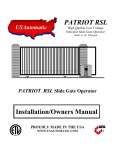
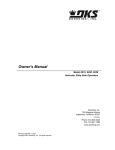
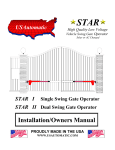
![PCR-258-Tip Kit Manual [110125]](http://vs1.manualzilla.com/store/data/005777628_1-f6da4e9104aae97408b67d66533e329f-150x150.png)

